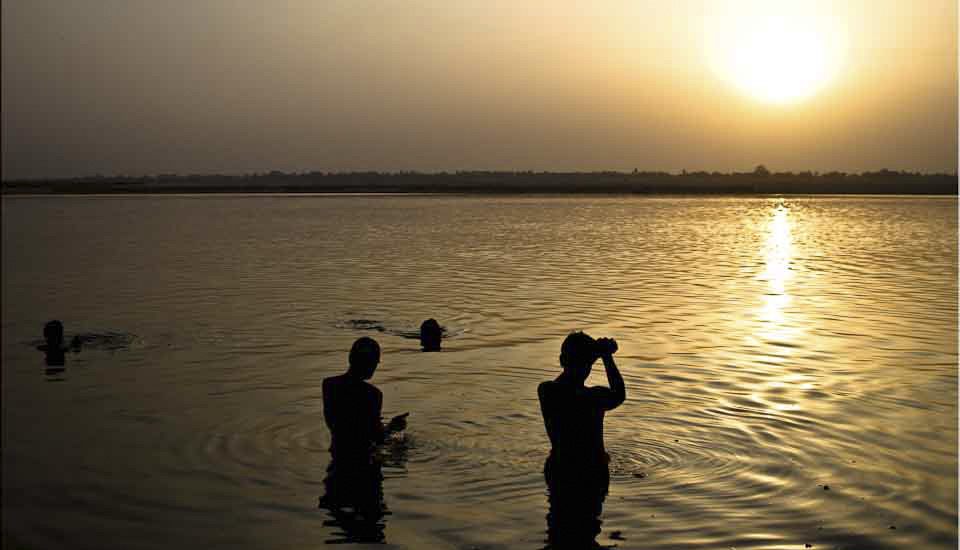.jpg)
Huli Warrior
Standing tall and proud in his carefully-applied yellow and red warpaint, and wearing his magnificent headdress made of woven hair adorned with precious parrot and bird of paradise feathers, a Huli Wigman is a formidable sight.
They are as colourful and distinctive as the birds of paradise that live high in the jungle tree-tops.
Today, the iconic Huli Wig Men of Hela Province in the Southern Highlands are immediately recognisable from advertising campaigns promoting travel and sing sings (festivals of culture, music and dance) in Papua New Guinea. Less than 100 years ago, however, they were completely unknown to the outside world.
Numbering between 250,000-800,000 people (sources vary wildly!), the Huli are one of the largest of Papua New Guinea’s more than 7000 different cultural groups. Their oral history traces back over thousands of years to one central ancestor named Hela. He had four sons and a daughter to whom he designated lands, and from whom the Hela nation of tribes – including the Huli – arose.
In the 1930s, Australian explorers and gold prospectors, Mick Leahy and Michael Dwyer, walked across what was then New Guinea, finding – to their surprise – cultivated lands and complex societies of ‘murdering bastards’. It had been assumed by Europeans that the interior of the island was unpopulated and was ‘simply a continuation of precipitous mountains and miasmic jungles’. Of course, the prior claim of the Huli to their own lands was not recognised, and their first contact with outsiders was in November 1934, when the Fox brothers – who had just parted company from Mick and Dan Leahy – killed at least fifty. Although the Huli are legendary for their fearsome warring natures – fighting with other clans over land, pigs, and women – their deadly bows and arrows were no match for European weaponry.
Feuds and clan warfare remain a fact of life today. With conflict over oil and gas production in the region, the failure of royalties to be disbursed as expected, frustrations and cross-cultural misunderstandings, and the easy access to high-powered guns (many trafficked across the border from West Papua), the old ‘rules’ of warfare have broken down, making the region more unpredictable and dangerous than ever.
I stayed well away from known hot-spots!
I was in Paiya Village with photographer Karl Grobl from Jim Cline Photo Tours and a small group of photography enthusiasts. Our hosts had arranged for three Asaro Mudmen (see: Asaro Mudmen), three Chimbu Skeleton Men (Watch this space!) and three Huli Wigmen to come and show us how they prepare themselves for war – or for a sing sing, as is more often the case these days. To be honest, I would not have been as brave about making pictures of these unsmiling and uncommunicative warriors if I had not trusted my hosts! Even without a shared language, I had fun with the Mudmen and Skeleton men; I very seldom achieved even a glimpse of eye contact with the Huli.
Fashioning their skirts, tails and armbands, applying their carefully designed face-paint, and feathering their elaborate headdresses is a long, painstaking process – and it is a wonder the Huli have the energy left over for war or for their peculiar up-and-down jumping Mali dance after hours of preening in the heat and humidity of the jungle. The growing and crafting of the wigs – for the elaborate Hulu headdresses are indeed made of human hair – is a whole other process (which I’ll talk about some other time -watch this space!) that takes many months and a bit of sorcery to create.
Join me in the jungle as they help each other prepare.
.jpg)
Paiya Housing
Roads (and the old colonial government) made no inroads here in the Highlands until the mid-1900s, but recent controversial natural gas projects have necessitated the development of highways and infrastructure. Even so, most thatched houses with their packed-mud floors are without electricity or running water.
.jpg)
Orb in its Web
The jungle is full of life. High overhead, parrots and birds of paradise can be heard – not that we saw any. What we did see were the huge golden orb spiders (Nephila pilipes) and their resiliant webs.

Putting on his Wig
One of the Huli warriors tests out his wig-and-feather headdress.

Ceremonial Winged Wig
Most wigmen have more than one headdress; ceremonial wigs sweep up like the wings of a bird.

Paradise and Parrot Feathers
Looking at all the feathers that go into sing sing costumes, it is a wonder that there are any bird of paradise or any parrots left!

Hornbill Beak and Boar Tusks
Huli men wear hornbill beaks, which symbolise strength and courage in battle, on their backs.

Face Painting
The multi-layered face-painting process starts with white clay known as momo and vermilion ochre or goloba, which signifies a warrior.

Chewing a New Paint Brush
Paint brushes are made by chewing one end of a soft twig from the surrounding jungle.

Huli Wigman Face Painting
Small hand mirrors – or sometimes just broken bits of mirrors – are essential tools. Betal (areca nut) chew and tobacco smoke are everywhere.

Painting the Yellow
Ambua, the bright yellow clay, is sacred – although for tourists and expediency, store-bought acrylic paints might be substituted.

Red Eyeliner
It has been suggested that the vibrant colours of the face paint not only instil fear in the Huli’s opponents, but also help the Huli men overcome their own fear and prepare themselves for battle (see: Tribal Body Art of PNG).

Fixing the Feathers
The final step in preparation is affixing the long feathers that are carefully wrapped up when not in use.

Ceremonial Wig
Tattooed, painted and feathered, the Huli Wigman stands tall in his ceremonial costume.

Three Wigmen
It is high noon by the time all three men are ready.

Wigmen in the Jungle
We gather them together and admire their makeup and traditional woven aprons.

Local Kids
Local children watch in fascination …

Kundu Drum
… as the men demonstrate their drum rhythms …

Fighting Stance
… and attack posture.

In the Jungle
These men are completely at home in the jungles where their ancestors have lived for thousands of years; …

Portrait: Huli Man in the Jungle
… most of us would be exhausted by the undergrowth and enervated by the heat in no time.

Portrait: Huli Wigman
This is my favourite portrait of the day: the club is pointed over my head and I finally have the trace of a smile.
Sometimes you have to work harder than others to bridge cultural gaps – but the effort is always worth it!

Until we meet again,
Keep Smiling!
Photos: 17August2017



























.png)


Wonderful post Ursula, you always do such an amazing and thorough job telling the story and providing background, factual info and of course you support it all with wonderful images! Bravo!
Thanks so much, Karl.
I’d do that trip again in a heartbeat! 😀
[…] private session with three Asaro Mudmen (see: Asaro Mudmen), three Huli Wigmen (see: Huli Wigmen), and three Chimbu Skeleton Men. We watched and photographed as they applied their traditional […]
[…] are one of the largest ethnic groups – and certainly one of the most distinctive (see: Meet the Huli Wig Men). Unknown to Europeans until 1934, they are believed to have lived in their region for many […]